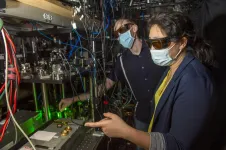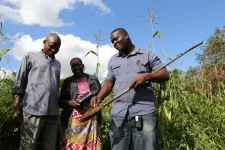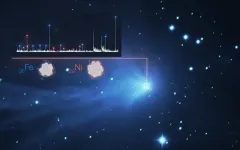(Press-News.org) A heart surgeon doesn't need to grasp quantum mechanics to perform successful operations. Even chemists don't always need to know these fundamental principles to study chemical reactions. But for Kang-Kuen Ni, the Morris Kahn associate professor of chemistry and chemical biology and of physics, quantum spelunking is, like space exploration, a quest to discover a vast and mysterious new realm.
Today, much of quantum mechanics is explained by Schrödinger's equation, a kind of master theory that governs the properties of everything on Earth. "Even though we know that, in principle, quantum mechanics governs everything," Ni said, "to actually see it is difficult and to actually calculate it is near-impossible."
With a few well-reasoned assumptions and some innovative techniques, Ni and her team can achieve the near-impossible. In their lab, they test current quantum theories about chemical reactions against actual experimental data to edge closer to a verifiable map of the laws that govern the mysterious quantum realm. And now, with ultracold chemistry--in which atoms and molecules are cooled to temperatures just above absolute zero where they become highly-controllable--Ni and her lab members have collected real experimental data from a previously unexplored quantum frontier, providing strong evidence of what the theoretical model got right (and wrong), and a roadmap for further exploration into the next shadowy layers of quantum space.
"We know the underlying laws that govern everything," said Ni. "But because almost everything on Earth is made of at least three or more atoms, those laws quickly become far too complex to solve."
In their study reported in Nature, Ni and her team set out to identify all the possible energy state outcomes, from start to finish, of a reaction between two potassium and rubidium molecules--a more complex reaction than had been previously studied in the quantum realm. That's no easy feat: At its most fundamental level, a reaction between four molecules has a massive number of dimensions (the electrons spinning around each atom, for example, could be in an almost-infinite number of locations simultaneously). That very high dimensionality makes calculating all the possible reaction trajectories impossible with current technology.
"Calculating exactly how energy redistributes during a reaction between four atoms is beyond the power of today's best computers," Ni said. A quantum computer might be the only tool that could one day achieve such a complex calculation.
In the meantime, calculating the impossible requires a few well-reasoned assumptions and approximations (picking one location for one of those electrons, for example) and specialized techniques that grant Ni and her team ultimate control over their reaction.
One such technique was another recent Ni lab discovery: In a study published in Nature Chemistry, she and her team exploited a reliable feature of molecules--their highly stable nuclear spin--to control the quantum state of the reacting molecules all the way through to the products. They also discovered a way to detect products from a single collision reaction event, a difficult feat when 10,000 molecules could be reacting simultaneously. With these two novel methods, the team could identify the unique spectrum and quantum state of each product molecule, the kind of precise control necessary to measure all 57 pathways their potassium rubidium reaction could take.
Over several months during the COVID-19 pandemic, the team ran experiments to collect data on each of those 57 possible reaction channels, repeating each channel once every minute for several days before moving on to the next. Luckily, once the experiment is set up, it can be run remotely: Lab members could stay home, keeping the lab re-occupancy at COVID-19 standards, while the system churned on.
"The test," said Matthew Nichols, a postdoctoral scholar in the Ni lab and an author on both papers, "indicates good agreement between the measurement and the model for a subset containing 50 state-pairs but reveals significant deviations in several state-pairs."
In other words, their experimental data confirmed that previous predictions based on statistical theory (one far less complex than Schrödinger's equation) are accurate--mostly. Using their data, the team could measure the probability that their chemical reaction would take each of the 57 reaction channels. Then, they compared their percentages with the statistical model. Only seven of the 57 showed a significant enough divergence to challenge the theory.
"We have data that pushes this frontier," Ni said. "To explain the seven deviating channels, we need to calculate Schrödinger's equation, which is still impossible. So now, the theory has to catch up and propose new ways to efficiently perform such exact quantum calculations."
Next, Ni and her team plan to scale back their experiment and analyze a reaction between only three atoms (one molecule and an atom). In theory, this reaction, which has far fewer dimensions than a four-atom reaction, should be easier to calculate and study in the quantum realm. And yet, already, the team discovered something strange: the intermediate phase of the reaction lives on for many orders of magnitude longer than the theory predicts.
"There is already mystery," Ni said. "It's up to the theorists now."
INFORMATION:
The amount of nutrients people get from the crops that they eat is a type of 'postcode lottery', according to new research that has analysed thousands of cereal grains and soils as part of a project to tackle hidden hunger in Malawi and Ethiopia.
A global team led by the University of Nottingham and its Future Food Beacon including academics and researchers from Addis Ababa University (AAU) in Ethiopia and Lilongwe University of Agriculture and Natural Resources (LUANAR) in Malawi, working on the GeoNutrition project, have discovered more about the relation between soils, crops and micronutrient deficiencies among people living there. Their ...
HERSHEY, Pa. -- Parkinson's disease is the second most common neurodegenerative disease and affects more than 10 million people around the world. To better understand the origins of the disease, researchers from Penn State College of Medicine and The Hebrew University of Jerusalem have developed an integrative approach, combining experimental and computational methods, to understand how individual proteins may form harmful aggregates, or groupings, that are known to contribute to the development of the disease. They said their findings could guide the development of new therapeutics to delay or even halt the progression of neurodegenerative diseases.
Alpha-synuclein ...
A new study by a Belgian team using data from the European Southern Observatory's Very Large Telescope (ESO's VLT) has shown that iron and nickel exist in the atmospheres of comets throughout our Solar System, even those far from the Sun. A separate study by a Polish team, who also used ESO data, reported that nickel vapour is also present in the icy interstellar comet 2I/Borisov. This is the first time heavy metals, usually associated with hot environments, have been found in the cold atmospheres of distant comets.
"It was a big surprise to detect iron and nickel atoms in the atmosphere of all the comets ...
Where you live may predict your long-term survival after experiencing a first heart attack. Socioeconomic factors -- such as income, education, employment, community safety and more -- have long been associated with cardiovascular health, but less is known about how neighborhood factors impact outcomes after myocardial infarction (MI), particularly among younger individuals. In an article published in JAMA Cardiology, researchers from Brigham and Women's Hospital and colleagues studied the health records of 2,002 patients who experienced an MI at or before age 50. They found that even after adjusting ...
What The Study Did: Researchers evaluated racial and ethnic diversity among obstetrics and gynecology, surgical and nonsurgical residents in the United States from 2014 to 2019.
Authors: Claudia L. Lopez, M.D., of the University of California, Davis, is the corresponding author.
To access the embargoed study: Visit our For The Media website at this link https://media.jamanetwork.com/
(doi:10.1001/jamanetworkopen.2021.9219)
Editor's Note: The article includes funding/support disclosures. Please see the article for additional information, including other authors, author contributions and affiliations, conflict of interest and financial disclosures, and funding and support.
# ...
What The Study Did: Registry data were used to examine the association between living in a socioeconomically disadvantaged area and long-term survival among patients who had their first heart attack at or before age 50.
Authors: Ron Blankstein, M.D., of Brigham and Women's Hospital in Boston, is the corresponding author.
To access the embargoed study: Visit our For The Media website at this link https://media.jamanetwork.com/
(doi:10.1001/jamacardio.2021.0487)
Editor's Note: The article includes conflict of interest disclosures. Please see the articles for additional information, including other authors, author contributions and affiliations, conflicts of interest and financial ...
What The Study Did: This study looked at the use of consumer digital information for COVID-19 control U.S. adults consider to be acceptable and the factors associated with higher or lower approval of using this information.
Authors: David Grande, M.D., M.P.A., of the University of Pennsylvania, is the corresponding author.
To access the embargoed study: Visit our For The Media website at this link https://media.jamanetwork.com/
(doi:10.1001/jamanetworkopen.2021.10918)
Editor's Note: The article includes conflict of interest and funding/support disclosures. Please see the article for additional information, including other authors, author contributions and affiliations, conflict of interest and financial disclosures, and funding and support.
# # #
Media advisory: ...
What The Study Did: SARS-CoV-2 seropositivity wasn't associated with low levels of vitamin D independently of other risk factors.
Authors: Yonghong Li, Ph.D., of Quest Diagnostics in San Juan Capistrano, California, is the corresponding author.
To access the embargoed study: Visit our For The Media website at this link https://media.jamanetwork.com/
(doi:10.1001/jamanetworkopen.2021.11634)
Editor's Note: The article includes funding/support disclosures. Please see the article for additional information, including other authors, author contributions and affiliations, ...
What The Study Did: Clinical characteristics and outcomes of patients with multisystem inflammatory syndrome among adults with laboratory-confirmed SARS-CoV-2 infection at a single U.S. medical center are described in this study.
Authors: Giovanni E. Davogustto, M.D., of the Vanderbilt University Medical Center in Nashville, Tennessee, is the corresponding author.
To access the embargoed study: Visit our For The Media website at this link https://media.jamanetwork.com/
(doi:10.1001/jamanetworkopen.2021.10323)
Editor's Note: The article includes conflicts of interest and funding/support disclosures. Please see the article for additional information, including other authors, author contributions and affiliations, conflict of interest and financial disclosures, ...
What The Study Did: Racial and ethnic representation among departmental chairs and faculty in academic medicine in the United States from 1980 to 2019 was examined in this study.
Authors: Darrion Mitchell, M.D., Ph.D., of the Ohio State University James Cancer Center in Columbus, is the corresponding author.
To access the embargoed study: Visit our For The Media website at this link https://media.jamanetwork.com/
(doi:10.1001/jamanetworkopen.2021.10726)
Editor's Note: The article includes conflicts of interest disclosures. Please see the article for additional information, including other authors, author contributions and affiliations, conflict of interest and financial disclosures, and ...


